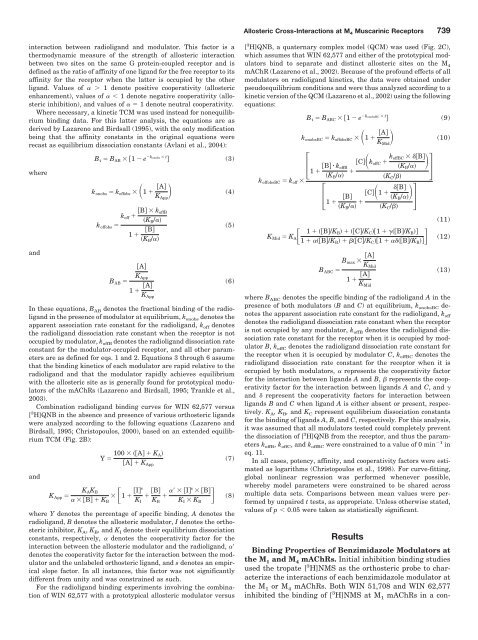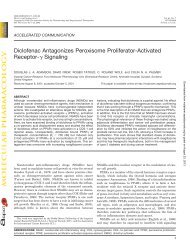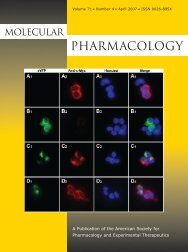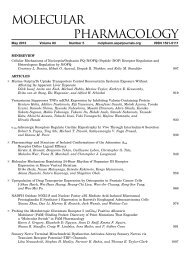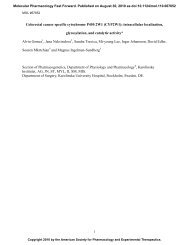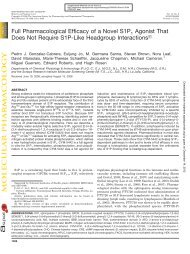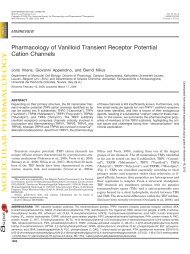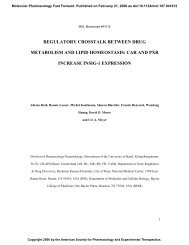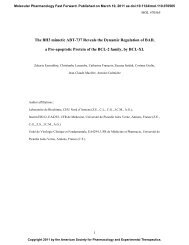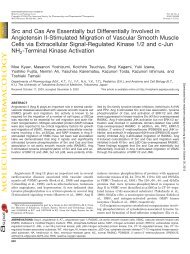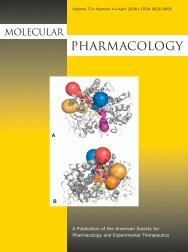Interaction Studies of Multiple Binding Sites on M4 Muscarinic ...
Interaction Studies of Multiple Binding Sites on M4 Muscarinic ...
Interaction Studies of Multiple Binding Sites on M4 Muscarinic ...
Create successful ePaper yourself
Turn your PDF publications into a flip-book with our unique Google optimized e-Paper software.
Allosteric Cross-<str<strong>on</strong>g>Interacti<strong>on</strong></str<strong>on</strong>g>s at M 4 <strong>Muscarinic</strong> Receptors 739<br />
interacti<strong>on</strong> between radioligand and modulator. This factor is a<br />
thermodynamic measure <str<strong>on</strong>g>of</str<strong>on</strong>g> the strength <str<strong>on</strong>g>of</str<strong>on</strong>g> allosteric interacti<strong>on</strong><br />
between two sites <strong>on</strong> the same G protein-coupled receptor and is<br />
defined as the ratio <str<strong>on</strong>g>of</str<strong>on</strong>g> affinity <str<strong>on</strong>g>of</str<strong>on</strong>g> <strong>on</strong>e ligand for the free receptor to its<br />
affinity for the receptor when the latter is occupied by the other<br />
ligand. Values <str<strong>on</strong>g>of</str<strong>on</strong>g> 1 denote positive cooperativity (allosteric<br />
enhancement), values <str<strong>on</strong>g>of</str<strong>on</strong>g> 1 denote negative cooperativity (allosteric<br />
inhibiti<strong>on</strong>), and values <str<strong>on</strong>g>of</str<strong>on</strong>g> 1 denote neutral cooperativity.<br />
Where necessary, a kinetic TCM was used instead for n<strong>on</strong>equilibrium<br />
binding data. For this latter analysis, the equati<strong>on</strong>s are as<br />
derived by Lazareno and Birdsall (1995), with the <strong>on</strong>ly modificati<strong>on</strong><br />
being that the affinity c<strong>on</strong>stants in the original equati<strong>on</strong>s were<br />
recast as equilibrium dissociati<strong>on</strong> c<strong>on</strong>stants (Avlani et al., 2004):<br />
where<br />
and<br />
B t B AB 1 e k<strong>on</strong>obs t (3)<br />
k <strong>on</strong>obs k <str<strong>on</strong>g>of</str<strong>on</strong>g>fobs 1 A<br />
K App (4)<br />
k <str<strong>on</strong>g>of</str<strong>on</strong>g>f B k <str<strong>on</strong>g>of</str<strong>on</strong>g>fB<br />
K B /<br />
k <str<strong>on</strong>g>of</str<strong>on</strong>g>fobs <br />
1 B<br />
K B /<br />
B AB <br />
A<br />
K App<br />
(5)<br />
1 A<br />
K App<br />
(6)<br />
In these equati<strong>on</strong>s, B AB denotes the fracti<strong>on</strong>al binding <str<strong>on</strong>g>of</str<strong>on</strong>g> the radioligand<br />
in the presence <str<strong>on</strong>g>of</str<strong>on</strong>g> modulator at equilibrium, k <strong>on</strong>obs denotes the<br />
apparent associati<strong>on</strong> rate c<strong>on</strong>stant for the radioligand, k <str<strong>on</strong>g>of</str<strong>on</strong>g>f denotes<br />
the radioligand dissociati<strong>on</strong> rate c<strong>on</strong>stant when the receptor is not<br />
occupied by modulator, k <str<strong>on</strong>g>of</str<strong>on</strong>g>fB denotes the radioligand dissociati<strong>on</strong> rate<br />
c<strong>on</strong>stant for the modulator-occupied receptor, and all other parameters<br />
are as defined for eqs. 1 and 2. Equati<strong>on</strong>s 3 through 6 assume<br />
that the binding kinetics <str<strong>on</strong>g>of</str<strong>on</strong>g> each modulator are rapid relative to the<br />
radioligand and that the modulator rapidly achieves equilibrium<br />
with the allosteric site as is generally found for prototypical modulators<br />
<str<strong>on</strong>g>of</str<strong>on</strong>g> the mAChRs (Lazareno and Birdsall, 1995; Trankle et al.,<br />
2003).<br />
Combinati<strong>on</strong> radioligand binding curves for WIN 62,577 versus<br />
[ 3 H]QNB in the absence and presence <str<strong>on</strong>g>of</str<strong>on</strong>g> various orthosteric ligands<br />
were analyzed according to the following equati<strong>on</strong>s (Lazareno and<br />
Birdsall, 1995; Christopoulos, 2000), based <strong>on</strong> an extended equilibrium<br />
TCM (Fig. 2B):<br />
and<br />
Y 100 A K A<br />
A K App<br />
(7)<br />
K A K B<br />
K App <br />
1 Is<br />
B<br />
Is B<br />
B K B K I K B K I K B<br />
(8)<br />
where Y denotes the percentage <str<strong>on</strong>g>of</str<strong>on</strong>g> specific binding, A denotes the<br />
radioligand, B denotes the allosteric modulator, I denotes the orthosteric<br />
inhibitor, K A , K B , and K I denote their equilibrium dissociati<strong>on</strong><br />
c<strong>on</strong>stants, respectively, denotes the cooperativity factor for the<br />
interacti<strong>on</strong> between the allosteric modulator and the radioligand, <br />
denotes the cooperativity factor for the interacti<strong>on</strong> between the modulator<br />
and the unlabeled orthosteric ligand, and s denotes an empirical<br />
slope factor. In all instances, this factor was not significantly<br />
different from unity and was c<strong>on</strong>strained as such.<br />
For the radioligand binding experiments involving the combinati<strong>on</strong><br />
<str<strong>on</strong>g>of</str<strong>on</strong>g> WIN 62,577 with a prototypical allosteric modulator versus<br />
[ 3 H]QNB, a quaternary complex model (QCM) was used (Fig. 2C),<br />
which assumes that WIN 62,577 and either <str<strong>on</strong>g>of</str<strong>on</strong>g> the prototypical modulators<br />
bind to separate and distinct allosteric sites <strong>on</strong> the M 4<br />
mAChR (Lazareno et al., 2002). Because <str<strong>on</strong>g>of</str<strong>on</strong>g> the pr<str<strong>on</strong>g>of</str<strong>on</strong>g>ound effects <str<strong>on</strong>g>of</str<strong>on</strong>g> all<br />
modulators <strong>on</strong> radioligand kinetics, the data were obtained under<br />
pseudoequilibrium c<strong>on</strong>diti<strong>on</strong>s and were thus analyzed according to a<br />
kinetic versi<strong>on</strong> <str<strong>on</strong>g>of</str<strong>on</strong>g> the QCM (Lazareno et al., 2002) using the following<br />
equati<strong>on</strong>s:<br />
1 <br />
k <str<strong>on</strong>g>of</str<strong>on</strong>g>fobsBC k <str<strong>on</strong>g>of</str<strong>on</strong>g>f <br />
B t B ABC 1 e k<strong>on</strong>obsBC t (9)<br />
k <strong>on</strong>obsBC k <str<strong>on</strong>g>of</str<strong>on</strong>g>fobsBC 1 A<br />
K Mid (10)<br />
B k <str<strong>on</strong>g>of</str<strong>on</strong>g>fB<br />
<br />
K B /<br />
Ck <str<strong>on</strong>g>of</str<strong>on</strong>g>fC k <str<strong>on</strong>g>of</str<strong>on</strong>g>fBC B<br />
K B /<br />
K C /<br />
1 <br />
B C1 B<br />
K B / K C /<br />
K B /<br />
(11)<br />
K Mid K A 1 B/K B C/K C 1 B/K B <br />
(12)<br />
1 B/K B C/K C 1 B/K B <br />
B max A<br />
K Mid<br />
B ABC <br />
1 A<br />
(13)<br />
K Mid<br />
where B ABC denotes the specific binding <str<strong>on</strong>g>of</str<strong>on</strong>g> the radioligand A in the<br />
presence <str<strong>on</strong>g>of</str<strong>on</strong>g> both modulators (B and C) at equilibrium, k <strong>on</strong>obsBC denotes<br />
the apparent associati<strong>on</strong> rate c<strong>on</strong>stant for the radioligand, k <str<strong>on</strong>g>of</str<strong>on</strong>g>f<br />
denotes the radioligand dissociati<strong>on</strong> rate c<strong>on</strong>stant when the receptor<br />
is not occupied by any modulator, k <str<strong>on</strong>g>of</str<strong>on</strong>g>fB denotes the radioligand dissociati<strong>on</strong><br />
rate c<strong>on</strong>stant for the receptor when it is occupied by modulator<br />
B, k <str<strong>on</strong>g>of</str<strong>on</strong>g>fC denotes the radioligand dissociati<strong>on</strong> rate c<strong>on</strong>stant for<br />
the receptor when it is occupied by modulator C, k <str<strong>on</strong>g>of</str<strong>on</strong>g>fBC denotes the<br />
radioligand dissociati<strong>on</strong> rate c<strong>on</strong>stant for the receptor when it is<br />
occupied by both modulators, represents the cooperativity factor<br />
for the interacti<strong>on</strong> between ligands A and B, represents the cooperativity<br />
factor for the interacti<strong>on</strong> between ligands A and C, and <br />
and represent the cooperativity factors for interacti<strong>on</strong> between<br />
ligands B and C when ligand A is either absent or present, respectively.<br />
K A ,K B , and K C represent equilibrium dissociati<strong>on</strong> c<strong>on</strong>stants<br />
for the binding <str<strong>on</strong>g>of</str<strong>on</strong>g> ligands A, B, and C, respectively. For this analysis,<br />
it was assumed that all modulators tested could completely prevent<br />
the dissociati<strong>on</strong> <str<strong>on</strong>g>of</str<strong>on</strong>g> [ 3 H]QNB from the receptor, and thus the parameters<br />
k <str<strong>on</strong>g>of</str<strong>on</strong>g>fB , k <str<strong>on</strong>g>of</str<strong>on</strong>g>fC , and k <str<strong>on</strong>g>of</str<strong>on</strong>g>fBC were c<strong>on</strong>strained to a value <str<strong>on</strong>g>of</str<strong>on</strong>g> 0 min 1 in<br />
eq. 11.<br />
In all cases, potency, affinity, and cooperativity factors were estimated<br />
as logarithms (Christopoulos et al., 1998). For curve-fitting,<br />
global n<strong>on</strong>linear regressi<strong>on</strong> was performed whenever possible,<br />
whereby model parameters were c<strong>on</strong>strained to be shared across<br />
multiple data sets. Comparis<strong>on</strong>s between mean values were performed<br />
by unpaired t tests, as appropriate. Unless otherwise stated,<br />
values <str<strong>on</strong>g>of</str<strong>on</strong>g> p 0.05 were taken as statistically significant.<br />
Results<br />
<str<strong>on</strong>g>Binding</str<strong>on</strong>g> Properties <str<strong>on</strong>g>of</str<strong>on</strong>g> Benzimidazole Modulators at<br />
the M 1 and M 4 mAChRs. Initial inhibiti<strong>on</strong> binding studies<br />
used the tropate [ 3 H]NMS as the orthosteric probe to characterize<br />
the interacti<strong>on</strong>s <str<strong>on</strong>g>of</str<strong>on</strong>g> each benzimidazole modulator at<br />
the M 1 or M 4 mAChRs. Both WIN 51,708 and WIN 62,577<br />
inhibited the binding <str<strong>on</strong>g>of</str<strong>on</strong>g> [ 3 H]NMS at M 1 mAChRs in a c<strong>on</strong>-


